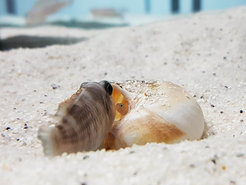Cichlid neuroethology

Teleost fish represent by far the most successful vertebrate lineage in terms of species number and degree of adaptations to diverse ecosystems. The family of Cichlidae is of particular interest, because in contrast to the majority of teleosts, they show extensive brood care comparable to that of social mammals, birds and insects. African cichlids are ideal for studying the evolution and neuronal underpinnings of diverse brood care strategies. Many cichlid species can be bred and hybridized in the laboratory and are amenable to genetic manipulations.
In cichlids from the great East African lakes, brood care is associated with other complex behaviors, such as pair bonding, nest building, protection of fry and territoriality. It is unknown how these advanced cognitive capacities are implemented at the neural circuit level and how behavioral diversity is generated from very similar genomes. Either new neuronal cell types have evolved to handle the complex social interactions, or a shared, ancestral circuitry is differentiated by small genetic changes.
To explore how different cichlids produce diverse behaviors, we use a multi-pronged approach, including single-cell transcriptomics, video-based tracking, genome engineering and optogenetics. We expect that the combination of these technologies will ultimately allow us to understand the genetic basis of a complex behavior.
